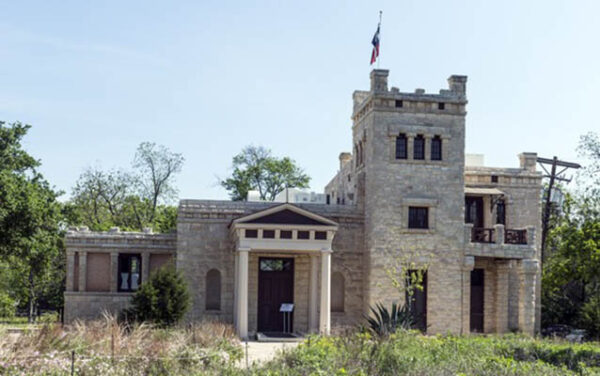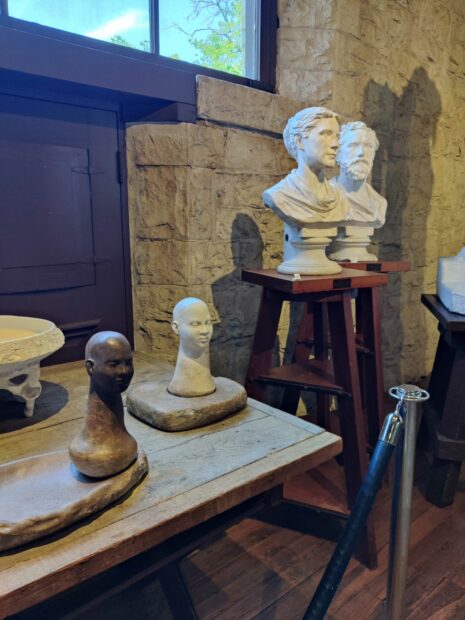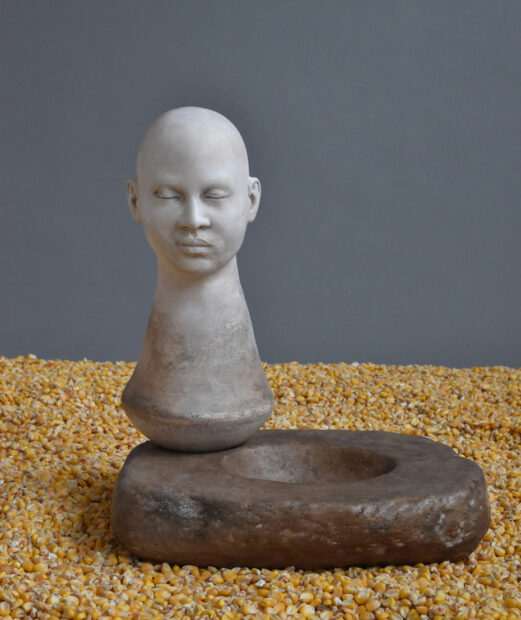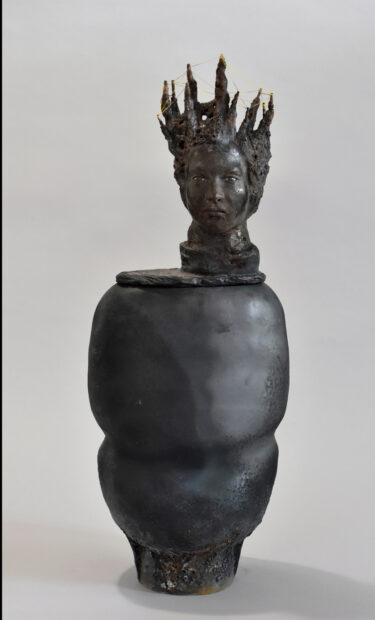In a castle-shaped, limestone building on a residential street in Austin, busts by two female, immigrant, Texas sculptors that lived a century apart sit side by side.
Alejandra Almuelle’s new exhibition De Tierra (Spanish, meaning “Of Earth“) at the Elisabet Ney Museum places her ceramic figurative sculptures among the museum’s permanent collection, revealing, through simple juxtapositions, the palimpsestic history of Texas as a place shaped by native plants and materials, as well as immigration and intersecting cultures.
Built in 1892, the museum is sculptress Elisabet Ney’s former home and studio, called Formosa (Portuguese, meaning “beautiful”). The works on view from the permanent collection testify to Ney’s artistic presence in vaunted intellectual and political circles of the 19th century, in her native Prussia, across Europe, and in Texas. There is a marble bust of Schopenhauer, plasters of Garibaldi and Bavaria’s King Ludwig II, as well as depictions of Texas icons Sam Houston and Stephen F. Austin.
Almuelle’s works in De Tierra sit among these sculptures of major historical figures, contrasting their classical style with Andean influence, drawn from the artist’s experiences in her native Peru. While both Ney and Almuelle’s compositions are intricate, the faces of Almuelle’s works are subtler. With either detailed, closed eyelids or arresting gazes, they seem more present than Ney’s classical figures who gaze — heroically or thoughtfully, but ultimately blankly — into the distance. Yet despite this contrast, the earthy colors of Almuelle’s pieces allow them to hide in plain sight in alcoves and on worktables, peppered amongst Ney’s works and the artifacts from her life on display in her home turned museum.
To be in the museum is to be in Ney’s personal and intimate space. The works Almuelle chose to exhibit similarly point to the intimate routines of daily life. Her figurative ceramics take on practical shapes, merging with mortar-and-pestles and vessels that recall activities like preparing food and gathering and storing water.
In Flor de Maiz (Corn flower) (2022), Almuelle merges figures with simple culinary tools while also treating the human form as a biological archive for experience. These tools shape the gestures people repeat throughout their lives and share with their descendents across centuries.
The Flor de Maiz series (2022) includes three shallow earthenware mortars with accompanying pestles. Each pestle is simultaneously a bust with a delicately rendered face, atop a neck that stretches and curves down to form the crushing tool. Bald and seemingly genderless, these pestle busts look like newly formed people. Their faces have blank expressions with gently closed eyes and mouths, as if they are waiting to be animated.
If used, these pestle-shaped people can crush material to create powder, or dust, filled with potential. They can grind spices, crush corn to make life (and culture-) sustaining foods, turn local plants like those filling the museum grounds into powders for dyes, or, perhaps, create the dust that humanity was molded from, as told in the myth and the Catholic iconography Almuelle encountered in Peru.
Almuelle sculpted these porcelain and earthenware objects with her hands, imbuing them with another layer of intimacy. Elisabet Ney, by contrast, sculpted by hand with plaster only as a means to an end, creating studies for final products ultimately rendered in Italian marble. For these works, she chipped away at the stone, carving rather than building up material. Thus, the tools that shaped Ney’s life and livelihood as an immigrant to Texas are different from the ones Almuelle uses and references as a product of her experience as a sculptress, Texan, and immigrant from Peru.
Upstairs on the museum’s second floor, De Tierra continues with Of the Land (2021), a series of earthenware vessels with sculpted heads. Three of these works feature the detailed heads of women and are arranged together on a wooden table. But tucked in an alcove in the stairwell, separate from the rest of the series, the first object visitors encounter from Of the Land looks like a work in progress, with the head detached from the vessel. Like the pestles of Flor de Maiz, the earthenware head paired with the vessel in the alcove is bald, visually simple, and seems at rest. While its eyes are open, it lacks pupils. This feature in particular sets the figurative part of the sculpture apart from the other vessels in the series. The heads on the other three look out from detailed eyes rendered in shades of gray, painted into the glaze.
The head on the darkest piece in the series wears a kind of crown of stalagmites, connected by strands of gold, that merges with her head. The color of volcanic ash, she is crowned by the earth and seems more like a mythological figure than a representation of an individual. The other two works, united by their chalky coloring and vessel shapes that resemble arrowheads, are subtly shaded with gradations of glaze. Their faces are similar, but have different noses and brow bones; one wears a headscarf, and the other has an abstracted updo or hat of folded-over clay piled on top of her head, evoking the elaborate styles of aristocracies past. Their gazes convey an intriguing mix of hesitancy and pride, which seem to question the viewer and the horizon.
What would these vessel women say to the figures of Ney’s oeuvre, with which they share a museum?
The faces are detailed enough to potentially represent individual people, but they are anonymous, identified only as “of the land,” a phrase that could equally apply to Ney’s marbles and even the gallery’s limestone walls.
As sculptresses, both Ney and Almuelle make work out of the land, but through immigration they are separated from their native soils. While Ney’s artistic work represents those who defined particular places through their ideas or use of power, Almuelle’s figures are anonymous.
And yet, the practical tools that form the bodies of her figures allude to lifeway defining activities, and her titles indicate the sculptures’ connections to particular natural environments. Different though their figures may look and their lives may be, Ney and Almuelle’s works form a wide-ranging dialogue.
De Tierra is on view through July 30, 2023 at the Elisabet Ney Museum in Austin.







1 comment
So glad that I can see artists like Alejandra Almuelle.